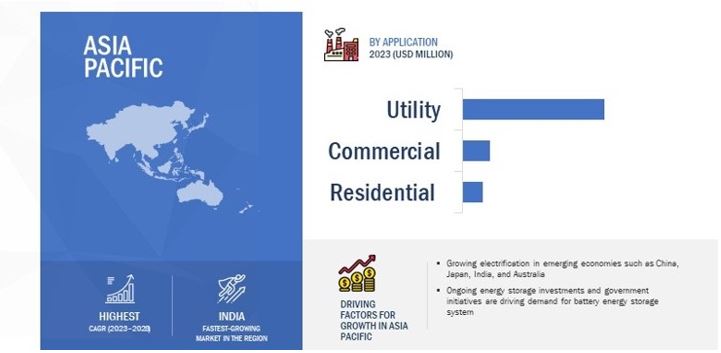Chicago, June 25, 2024 (GLOBE NEWSWIRE) -- The global Battery Energy Storage System Market Size is estimated to be worth USD 5.4 Billion in 2023 and is projected to reach USD 17.5 Billion by 2028, at a CAGR of 26.4% during the forecast period.
The market is expanding due to several factors. These include the rising demand for grid energy storage systems as part of ongoing grid modernization efforts, the increasing use of lithium-ion batteries, and the growing adoption of low-carbon and less fossil fuel-dependent economies. Additionally, the ongoing revolution in renewable energy is contributing to this battery energy storage system industry growth.
To know about the assumptions considered for the study
Major Battery Energy Storage System Companies Include:
- BYD Company Limited,
- SAMSUNG SDI Co., Ltd.,
- LG Energy Solutions Co., Ltd., and
- Panasonic Corporation.
Battery Energy Storage System Market Segmentation Analysis:
The Battery Energy Storage System (BESS) market is segmented based on several key factors, including battery type, connection type, ownership, energy capacity, and application. Here's an overview of the segmentation analysis:
- Battery Type:
- Lithium-ion Batteries: Dominant in the market due to their high energy density, efficiency, and decreasing costs. These batteries are widely used across various applications, including residential, commercial, and utility-scale projects.
- Advanced Lead Acid Batteries: Known for their reliability and safety, these are often used in small to medium-scale energy storage solutions.
- Flow Batteries: These batteries are gaining traction due to their long cycle life and are ideal for large-scale energy storage applications.
- Connection Type:
- On-Grid: Systems connected to the main power grid, providing energy storage for grid stabilization, peak shaving, and energy arbitrage.
- Off-Grid: Used in remote locations or areas without reliable grid access, these systems provide standalone power solutions, often paired with renewable energy sources like solar or wind.
- Ownership:
- Customer Owned: Systems owned by end-users, including residential, commercial, and industrial customers.
- Third-Party Owned: Operated by companies that provide energy storage as a service.
- Utility Owned: Owned and operated by utility companies for grid management and efficiency improvements.
- Energy Capacity:
- Below 100 MWh: Typically used for residential and small commercial applications.
- 100-500 MWh: Suitable for larger commercial and industrial uses.
- Above 500 MWh: Mainly used in utility-scale projects, providing significant energy storage for grid support and renewable energy integration.
- Application:
- Utility: The largest segment, involving large-scale energy storage projects aimed at enhancing grid reliability, integrating renewable energy sources, and providing backup power.
- Residential: Growing rapidly as homeowners adopt energy storage to complement rooftop solar installations, reduce energy bills, and ensure backup power during outages.
- Commercial & Industrial: Used for demand charge management, backup power, and enhancing the integration of on-site renewable energy systems.
By Region, Asia Pacific is the highest growing region for battery energy storage system market during forecast period

Asia Pacific rapid economic growth, urbanization, and industrialization have resulted in higher energy consumption. This increased demand for energy, along with the need for reliable and sustainable power supply, has driven the adoption of battery energy storage systems. The use of residential energy storage technology will enable to increase access to electricity for these remote and island communities in the region. Energy storage investments are expected to increase substantially within the region as the governments in growing economies are making new policies to improve the reliability and quality of the power distribution facilities to the residential customers. The growth of the market in the region is driven by several factors, including the increasing demand for renewable energy, growing concerns about climate change, improvements in battery technology, and government policies and regulations.
China is a major player in the market, with significant investments in large-scale battery energy storage projects to complement its massive renewable energy capacity. The Chinese government's supportive policies and ambitious targets for renewable energy adoption are key factors fueling market growth.
Japan is also making substantial strides, driven by its energy policies focusing on renewable energy integration and disaster resilience. The country’s focus on technological advancements and innovation in battery storage solutions further boosts its market position.
South Korea’s market growth is propelled by its strong manufacturing base for battery technologies and supportive government policies aimed at promoting clean energy and reducing carbon emissions.
